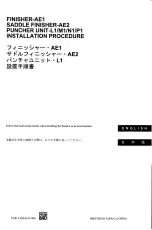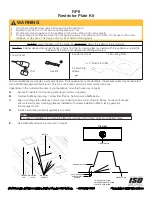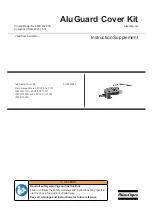
Fig.
1
: Mounting on the wall
3. Installation
Before mounting, check whether there are any lines running at the selected
mounting location.
Mark the drill holes on the wall according to the hole spacing of the back plate
(drilling template on back plate). Please use a spirit level for this purpose.
Drill holes (Ø
5
mm), align the back plate horizontally with dowels and screws
(included in the scope of delivery) and fasten.
Make sure that you attach the back plate so that the recess for the plug-in seal
points upwards, as shown in the following sketch. First place the Indoor T+H
Sensor laterally from the right onto the cams of the back plate, then carefully
press the front part against the back plate until the retaining cams on the left
side also engage in the front part. In addition, insert the plug-in seal to prevent
unauthorized removal of the device. Please note the following illustration.
Tip: If necessary, use washers for uneven wall.
Important
■
Do not mount the sensor near additional heat sources, e.g. kitchen
stove, or in places with direct sunlight.
■
Mount the sensor at a distance of at least 1.5 m from the floor and at
least 1 m from the nearest radiator.
■
Do not mount the sensor on an outside wall or near a door. When
mounting the device over an empty pipe opening, make sure to seal
the pipe to avoid adverse air currents.
4. Commissioning and radio activation
The Indoor T+H Sensor has a Plug&Play commissioning mode. After placing the
Indoor T+H Sensor on the back plate, the radio activation takes place
automatically. The display appears after 20 seconds. The Indoor T+H Sensor
measures temperature and relative humidity and transmits the measured
values either via wireless M-Bus radio or via LoRaWAN® radio, depending on the
configuration of the device.
Alternatively, the radio can also be activated using the ZENNER MSS software,
the MinoConnect universal interface (USB or Bluetooth radio) and the special
ZENNER infrared optical head IrCombiHead. To do this, please activate the
«SetOperatingMode» field in the MSS software.
In case of LoRaWAN® the device sends a join request to the server (LNS) and
waits for the acceptance (join accept). If there is no connection, another
request is sent every minute (max. 5 requests). The radio symbol in the
display shows the status of the connection process:
■
blinking fast: no response from the server yet.
■
permanently displayed: successful connection.
In case of unsuccessful joining, the device sends a random joining request
every further day until a successful connection is made (LED does not indicate
later connection attempts).
To check the radio technology currently activated in the device, the device
parameters can be read out using the MSS software. The set radio technology
can also be seen on the display:
When LoRaWAN® join has been completed, the radio symbol is permanently
shown in the upper left corner of the display. In the case of wireless M-Bus, the
symbol flashes every 2 seconds.
5. Disassembly
First remove the plug-in seal (if necessary, your security tag must be
removed beforehand). Please use a suitable slotted screwdriver and turn
the seal until it breaks.
After that, please carefully insert a suitable slotted screwdriver into one of
the two left openings and gently push the tool in until the clip is released.
Now move the screwdriver away from the wall until the Indoor T+H Sensor
lifts off the back plate. Now repeat the same on the second opening.
If the Indoor T+H Sensor is not dismantled as described, but is removed
from the back plate with great force, the housing or the back plate may be
damaged.
6. Data logger
The Indoor T+H Sensor has an internal memory (data logger). The readout
of stored data, such as daily, semi-monthly and monthly values, is carried
out via the optical interface using MinoConnect (USB or radio), the ZENNER
IrCombiHead opto head and appropriate software license.
Data logger content
Daily values
32
Half-monthly values
18
Monthly values
18
Plug-in seal
LCD Display
Dowels
Screws
Optical interface
Back plate with slotted holes
Fig. 2: Disassembly from the back plate
























